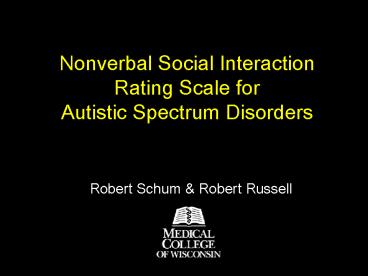Nonverbal Social Interaction Rating Scale for Autistic Spectrum Disorders - PowerPoint PPT Presentation
1 / 17
Title:
Nonverbal Social Interaction Rating Scale for Autistic Spectrum Disorders
Description:
difficult to untangle language functions from social functions ... Baron-Cohen, S., Cox, A., Baird, G., Swettenham, J., Nightingale, N., Morgan, K., et al. (1996) ... – PowerPoint PPT presentation
Number of Views:24
Avg rating:3.0/5.0
Title: Nonverbal Social Interaction Rating Scale for Autistic Spectrum Disorders
1
Nonverbal Social Interaction Rating Scale for
Autistic Spectrum Disorders
- Robert Schum Robert Russell
2
Diagnostic Criteria for Autism
- communication impairment
- social impairment
- restricted/stereotypical behaviors and interests
3
Problem of Differential Diagnosis for Autism
- difficult to untangle language functions from
social functions - social disorder is key distinguishing criterion
between autism spectrum disorders and other
developmental disorders - autism 1166, SLI 117, MR 150
4
Interview and Play Assessments
5
Differentiating Social Behaviors
- direct imitation
- joint attention
- affective reciprocity
- representational play
6
Participants
- N 60
- 2-7 years old
- nonverbal IQ gt 70
- agreed to 3-year follow-up
7
Procedure
- team evaluation neurodevelopmental pediatrician,
speech-language pathologist, clinical
psychologist - psychologist rated CARS, placed aside
- team met 1 month later, determined diagnosis
- psychologist rated behavior descriptions in
reports 3 years later for nonverbal social
behaviors
8
Nonverbal Social Interaction Rating Scale (NSIRS)
9
Imitation (IM)
- Child directly imitates action of examiner (e.g.,
tapping table with hand or object, touching parts
of head, drawing lines on paper, wiggling thumb,
jumping, making mouth noises such as tongue click
or raspberry).
10
Joint attention (JA)
- Showing toy to adult, but not requesting any
assistance pointing to object and looking at
adult alternating gaze between looking at adult
and looking at object/event language could be
used as part of action, but not necessary (e.g.,
look, Mommy).
11
Affective reciprocity (AR)
- Laughing with adult over a silly event, such as
when examiner feigns distress as a tower of
blocks topples over child repeats action to
elicit repeated silly action from examiner child
giggles in playing peek-a-boo, chase game, or in
anticipation during tickle game.
12
Representative play (RP)
- Arranging human figures in playhouse on furniture
and in representative actions pretending to cook
or eat food offering a bottle to a baby doll
combining two toys in a scheme (e.g., putting a
human figure astride a dinosaur).
13
Results
- inter-item reliability
- r .15 - .44
- concurrent validity with CARS
- r .61 (p lt .001)
- NSIRS scores per Dx M (SD)
- Autism 5.3 (2.0) (n 9)
- SLI 6.8 (1.4) (n 51)
- F 7.16 (p lt .01)
14
3-Year Follow-up
- NSIRS-CARS (parent) r .35 (p lt .02)
- Childrens Communication Checklist-2
- nonverbal section
- NSIRS Teacher r .52 (p lt.001)
- NSIRS Parent r .35 (p lt .02)
- Pragmatic Profile (CELF-IV)-nonverbal
- NSIRS Teacher r .22
- NSIRS Parent r .35 (p lt .02)
15
Conclusions
- use as a screening procedure rather than as a
diagnostic instrument - continued development
- larger N
- independent rater/diagnostic team
- look at developmental trends to include MR
16
rschum_at_mcw.edu
17
Assessment References
- Baron-Cohen, S., Cox, A., Baird, G., Swettenham,
J., Nightingale, N., Morgan, K., et al. (1996).
Psychological markers in the detection of autism
in infancy in a large population. British
Journal of Psychiatry, 168(2), 158-163. - Lord, C., Rutter, M., Le Couteur, A. (1994).
Autism Diagnostic Interview-Revised A revised
version of a diagnostic interview for caregivers
of individuals with possible pervasive
developmental disorders. Journal of Autism
Developmental Disorders, 24(5), 659-685. - Robertson, J. M., Tanguay, P. E., L'Ecuyer, S.,
Sims, A., Waltrip, C. (1999). Domains of
social communication handicap in autism spectrum
disorder. Journal of the American Academy of
Child Adolescent Psychiatry, 38(6), 738-745. - Stone, W. L., Coonrod, E. E., Turner, L. M.,
Pozdol, S. L. (2004). Psychometric properties of
the STAT for early autism screening. Journal of
Autism Developmental Disorders, 34(6), 691-701. - Wetherby, A., Prizant, B., Hutchinson, T.
(1998). Communicative, social/affective, and
symbolic profiles of young children with autism
and pervasive developmental disorders. American
Journal of Speech-Language Pathology, 7(2), 79-91.































